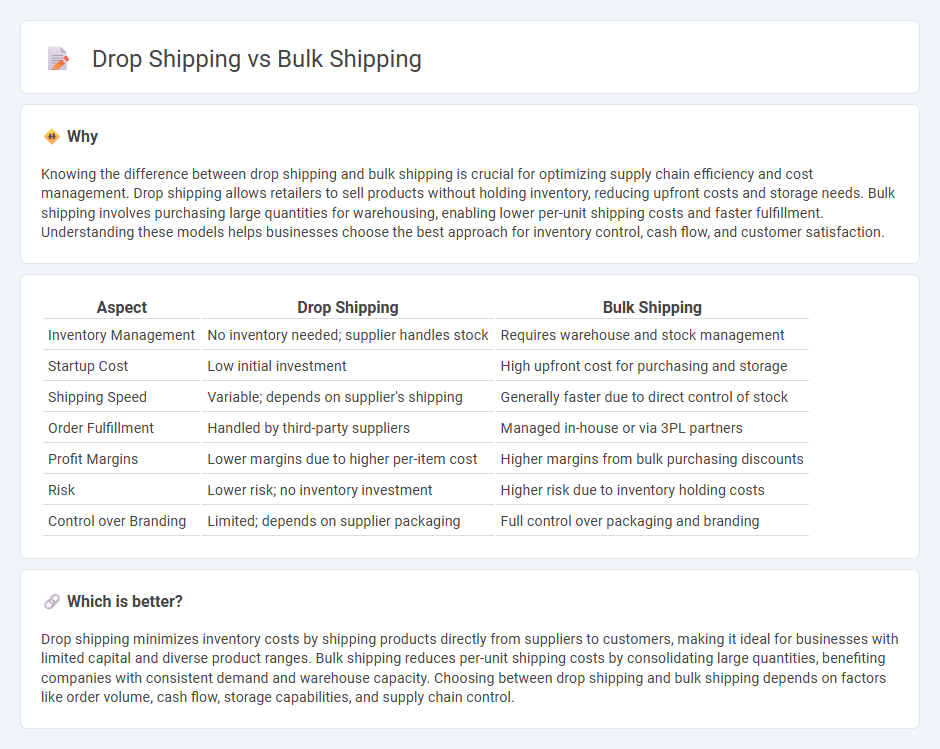
Drop shipping involves shipping products directly from the supplier to the customer, reducing inventory costs and enabling faster market entry. Bulk shipping requires purchasing and storing large quantities of products, allowing for lower per-unit costs and greater control over inventory management. Explore the key differences between drop shipping and bulk shipping to optimize your logistics strategy.
Why it is important
Knowing the difference between drop shipping and bulk shipping is crucial for optimizing supply chain efficiency and cost management. Drop shipping allows retailers to sell products without holding inventory, reducing upfront costs and storage needs. Bulk shipping involves purchasing large quantities for warehousing, enabling lower per-unit shipping costs and faster fulfillment. Understanding these models helps businesses choose the best approach for inventory control, cash flow, and customer satisfaction.
Comparison Table
| Aspect | Drop Shipping | Bulk Shipping |
|---|---|---|
| Inventory Management | No inventory needed; supplier handles stock | Requires warehouse and stock management |
| Startup Cost | Low initial investment | High upfront cost for purchasing and storage |
| Shipping Speed | Variable; depends on supplier's shipping | Generally faster due to direct control of stock |
| Order Fulfillment | Handled by third-party suppliers | Managed in-house or via 3PL partners |
| Profit Margins | Lower margins due to higher per-item cost | Higher margins from bulk purchasing discounts |
| Risk | Lower risk; no inventory investment | Higher risk due to inventory holding costs |
| Control over Branding | Limited; depends on supplier packaging | Full control over packaging and branding |
Which is better?
Drop shipping minimizes inventory costs by shipping products directly from suppliers to customers, making it ideal for businesses with limited capital and diverse product ranges. Bulk shipping reduces per-unit shipping costs by consolidating large quantities, benefiting companies with consistent demand and warehouse capacity. Choosing between drop shipping and bulk shipping depends on factors like order volume, cash flow, storage capabilities, and supply chain control.
Connection
Drop shipping and bulk shipping are connected through their roles in supply chain management, where bulk shipping facilitates the movement of large quantities of goods from manufacturers to warehouses or distribution centers, while drop shipping enables direct delivery from suppliers to customers without inventory holding. Efficient bulk shipping reduces per-unit transportation costs, supporting drop shipping operations by ensuring suppliers have sufficient stock availability to fulfill individual orders quickly. This synergy between bulk shipping and drop shipping optimizes inventory management, reduces lead times, and enhances customer satisfaction in e-commerce logistics.
Key Terms
Bulk Shipping:
Bulk shipping involves purchasing large quantities of products upfront, leading to cost savings through volume discounts and reduced per-unit shipping expenses, ideal for businesses with ample storage and predictable demand. This method enhances inventory control, ensures faster order fulfillment, and minimizes dependency on third-party suppliers compared to drop shipping. Explore comprehensive insights on how bulk shipping can streamline your supply chain and boost profitability.
Full Container Load (FCL)
Full Container Load (FCL) bulk shipping offers cost efficiency and enhanced control over inventory by consolidating large shipments into a single container, reducing per-unit transportation expenses. Drop shipping relies on sending smaller, individual orders directly from suppliers to customers, resulting in higher shipping costs and longer delivery times compared to FCL bulk shipping. Explore the advantages of FCL in shipping logistics to optimize your supply chain and reduce costs effectively.
Freight Consolidation
Freight consolidation in bulk shipping optimizes costs by combining multiple smaller shipments into a single larger load, reducing freight expenses and minimizing handling risks. Drop shipping eliminates the need for inventory storage by shipping products directly from suppliers to customers, but it often results in higher per-unit shipping costs and fragmented freight management. Discover how freight consolidation can streamline your supply chain and cut shipping costs in bulk versus drop shipping models.
Source and External Links
Bulk Shipping: Mass Shipping & Shipping Large Quantities - Bulk shipping involves transporting large quantities of unpackaged goods loaded into shipping containers, typically on ships, and follows key steps of transportation to port, loading on vessels, and unloading at destination ports for final delivery, often used in B2B and wholesale contexts.
All You Need to Know About Different Bulk Shipping Options - Bulk shipping options include bulk vessels for dry and liquid commodities, ISO tank containers for liquid goods, and flexitanks for non-hazardous liquids, each designed for efficient, large-volume transport by sea, rail, and road.
Bulk Shipping | Easy shipping eCommerce - Parcel Monkey - Bulk shipping tools allow users, especially businesses, to upload multiple shipment details at once via CSV files to quickly get discounted shipping rates and book shipments, streamlining sending large numbers of packages without extra fees or minimum volume requirements.
 dowidth.com
dowidth.com